welcome to biology concept building
Concept Developed by-Tufail Idris
- Biology is based on the fundamental laws of nature embodied in chemistry and physics, but the origin and evolution of life on earth were historical events.
- Evolution is Unifying principle in Biology and without considering evolution or phylogeny, we cannot understand Biology.
Q.1. What is Biology? Is it be integrated with Evolution to understand biology in a comprehensive way?
Ans- Biology is the scientific study of living things (Plants and Animals). The study of Plant life is called Botany and the study of animals life is called Zoology.
Organisms are individual living entities. For example, each tree in a forest is an organism. Single-celled prokaryotes and single-celled eukaryotes are also considered organisms and are typically referred to as microorganisms. Plants and animals possess a characteristic bodily organization that at once sets them off from minerals, rocks, andother lifeless things. For this reason they are called Organisms. The type of organization differs in the lower and higher forms of life. Nevertheless, all plants and animals, whether simple or complex, are known as organisms, and all substances, processes, arid laws peculiar to them are said to be organic.
Biologists define “living things” as all the diverse organisms descended from a single-celled ancestor that evolved almost 4 billion years ago. Because of their common ancestry, living organisms share many characteristics that are not found in the non-living world/In-animate world.The unifying properties of all living organisms/unifying principles of life are as under:
- Consist of one or more cells (Unicellular or Multicellular Organism)
- Contain genetic information (Presence of DNA/RNA)
- Use genetic information to reproduce themselves [Decoding Mechanism-Replication and Protein Synthesis (Transcription and Translation)
- Are genetically related (Heredity/Genetics) and have evolved (Phylogeny)
- Can convert molecules obtained from their environment into new biological molecules (Anabolism/Anabolic reactions-Photosynthesis)
- Can extract energy from the environment and use it to do biological work (Catabolism/Catabolic Reactions-Respiration)
- Can regulate their internal environment (Homeostasis)
Yes, it is preferred or necessary to integrate the concept of evolution to understand biology in a better way. Evolution is a central theme of biology. Through differential survival and reproduction, living systems evolve and become adapted to Earth’s diverse or many environments. The processes of evolution have generated the enormous diversity that we see today as life on Earth. Two important theories that unifies our knowledge of the animal world or that guide Biology researches are-
(1) the theory of evolution, which is the central organizing principle of biology (2) the chromosomal theory of inheritance, which guides our study of heredity and variation in animals.
Q.2. Define Living System?
Ans- A complex unit of physio-chemical material which is capable of growth, reproduction, self-regulation, adaption, respond to stimulus and metabolism is called Living System. Microbes (Bacteria/Cyanobacteria), Fungi, Plants and Animal cells are examples of living system. Despite obvious differences, all forms of life or living system share many molecular mechanisms, because they all descended from a common ancestor. Cell is the Structural, Functional and Fundamental unit of life.
It is thought that the entire diversity of modern-day life derives from a common original life form often referred to as the Last Universal Common Ancestor (LUCA) or Pro-genote, whose molecular components have been conserved from generation to generation, and from species to species, as different organisms have evolved. On comparing modern organisms, we find that the core building blocks of all organisms are the same. Hence, complex molecules (Macro-molecules) is the chemical foundation of cell or all life-forms. There are four major classes of biomolecules that are synthesized by living systems:
- Nucleic acids (DNA/RNA): Serves as or Acts Informational Molecule of the cell. DNA is the stable genetic material of all organisms from bacteria (first cell or first life to human (Most advanced and complex organism). Where-ever DNA is genetic material, RNA is Non-genetic and is involved in Protein synthesis. Nucleic Acid is the polymer of Nucleotides linked by phospho-di-ester bond. Nucleic Acid stores genetic information for the formation of complete organism [in the form of 4-alphabets of life-A,T (In DNA)/U (in RNA),C and G] and transmits genetic information from one generation to another or from parent to progeny/offspring or from one generation to another.
- Proteins: Serves as or Acts Performer Molecule/work-horses of the cell. Protein is the polymer of alpha-L Amino acis linked by peptide linkage bond (Chemically, Amide linkage). Protein carries out/serves for structural and functional roles.
- Lipids/Fats: Serves as or Acts Energy Molecule of the cell (Provides double energy than carbohydrate/polysarrides). When-ever both Lipid and Carbohydrate (Glucose: An instant source of energy in cell) then cell utilizes carbohydrate (glucose) as a source of energy and stores fat/lipids undernethe skin and liver. Lipid/Fat is the polymer of Fatty acid and glycerol linked by ester bond/linkage.
- Polysaccharides (carbohydrates): Serves as or Acts Energy Molecule of the cell (Preferred source of energy by the cell). Carbohydrate is the polymer of Mono-saccharide units or Sugars linked by Glycosidic linkage.
These complex molecules combines to form Suprer-molecules such as carbohydrate & protein in glycoproteins, lipid & protein in lipoproteins and carbohydrate & lipid in glycolipids.
All biomolecules are remarkably similar throughout the evolutionary or phylogenetic tree. Since living systems primarily exist within an aqueous environment, the unique structures and properties of biomolecules are determined by their reactions within this environment. The reactions between small molecules that take place in living systems depend on higher-order interactions between the larger biomolecules that modify the aqueous environment. Asgard archaea are a group of recently discovered Archea (Superphylum containing phylas like Loki-archeota, Thor-archota, Odina-archiota) that are closest relative of present day eukaryotes and provides valuable insights into the early evolution of complex life, particularly the origin of eukaryotic cells. They are thought to have played a crucial role in the evolution of eukaryotic cells.
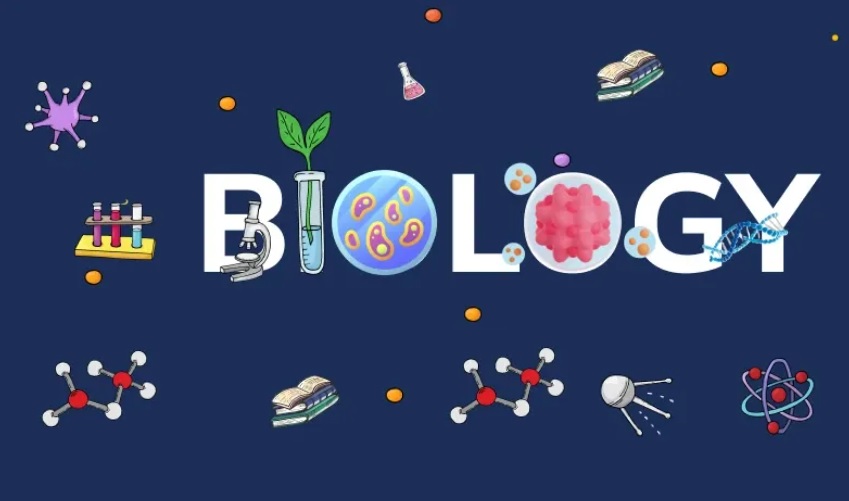


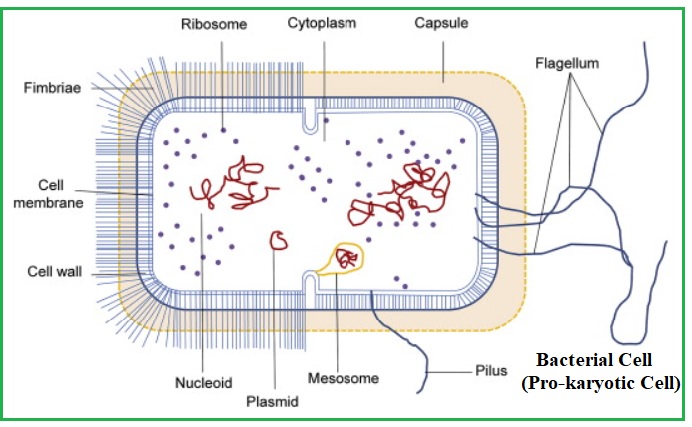
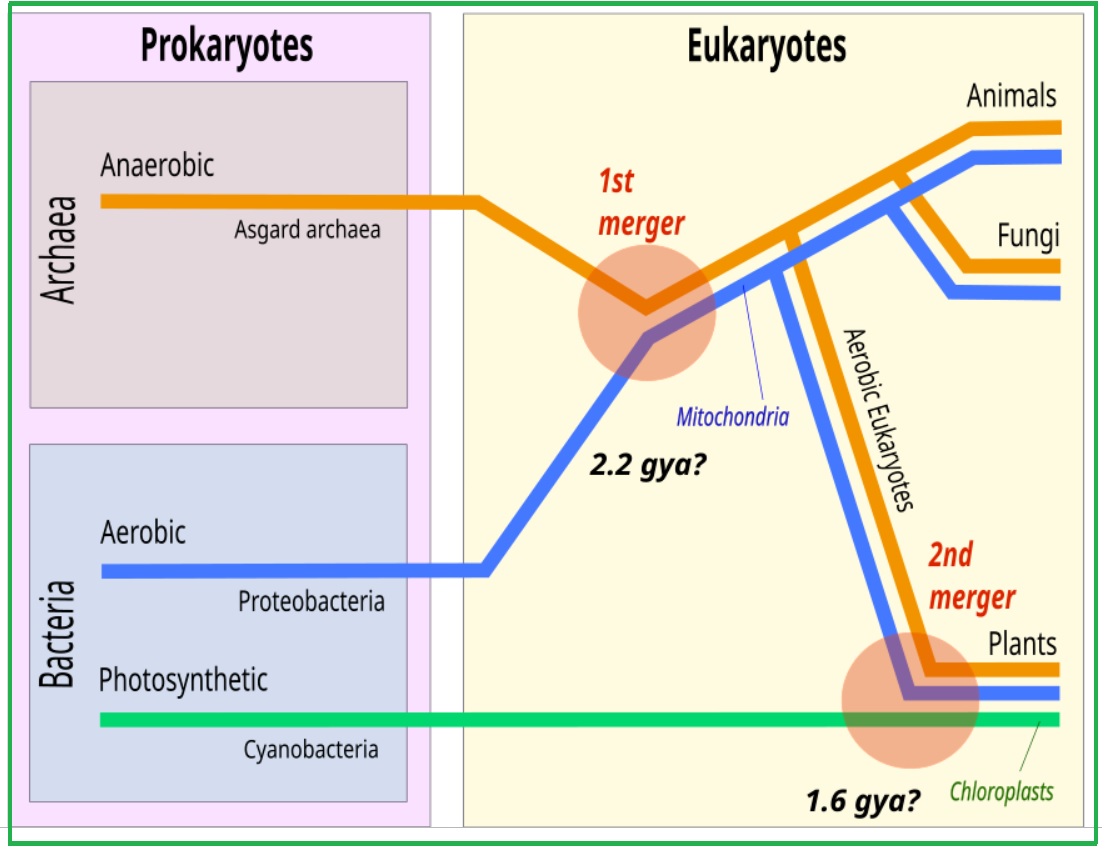
Animal cell & plant cell (Eukaryotic Cell)
DNA
bacterial cell
(pro-karyotic cell )
Q.3. Explain why Life is Carbon-based not Silicon-based?
Ans- Carbon (Atomic Number, C=6) and Silicon (Atomic Number, Si=14) belongs to same Group in Periodic table (Group-IVA or 14) but because of following reasons, organic life is Carbon-based.
Part-I : Carbon forms wide range of chemical bonds from strongest (In Diamond) to weakest (Graphite) while silicon forms strongest bond only that once formed cannot be broken eaisly. Breaking of silicon bonds require very high energy.
- The chemistry of living organisms is organized around carbon, which accounts for more than half the dry weight of cells. Carbon can form single bonds with hydrogen atoms, and both single and double bonds with oxygen and nitrogen atoms. Of greatest significance in biology is the ability of carbon atoms to form very stable carbon–carbon single bonds.
- Each carbon atom can form single bonds with up to four other carbon atoms. Two carbon atoms also can share two (or three) electron pairs, thus forming double (or triple) bonds.
- The four single bonds that can be formed by a carbon atom are arranged tetrahedrally, with an angle of about 109.5 between any two bonds and an average length of 0.154 nm. There is free rotation around each single bond. A double bond is shorter (about 0.134 nm) and rigid and allows little rotation about its axis.
Part-II: Catenation property (Ability of self-linking) is highest in Carbon than Silicon because of smallest size of carbon than silicon.
- Covalently linked carbon atoms in biomolecules can form linear chains, branched chains, and cyclic structures. To these carbon skeletons are added groups of other atoms, called functional groups, which confer specific chemical properties on the molecule.
- It seems likely that the bonding versatility of carbon was a major factor in the selection of carbon compounds for the molecular machinery of cells during the origin and evolution of living organisms. No other chemical element can form molecules of such widely different sizes and shapes or with such a variety of functional groups.
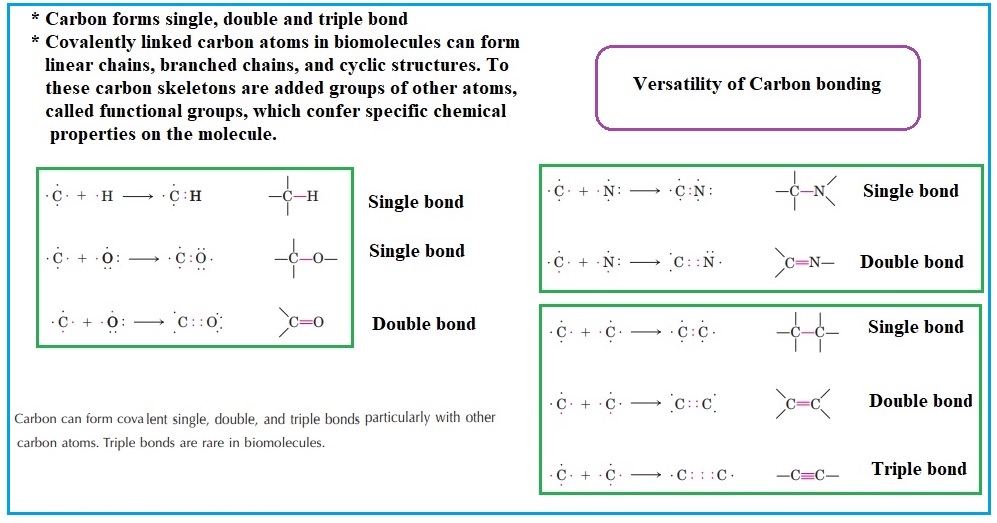

carbon
versatility in carbon bonding
silicon
Q.4. Explain the three Domains of Life from evolutionary point of view?
Ans- All organisms from simple bacteria to complex mammals probably evolved from a common, single celled progenitor. The greater the similarities in these macromolecular sequences, the more closely related organisms are thought to be. Although all organisms in the Eubacterial and Archaean lineages are prokaryotes, archaea are more similar to eukaryotes than to eubacteria (“true” bacteria) in some respects. For instance-
- Archaean and Eukaryotic genomes encode homologous histone proteins, which associate with DNA; in contrast, bacteria lack histones.
- Likewise, the RNA and protein components of archaean ribosomes are more like those in eukaryotes than those in bacteria.
Part-I : The first forms of life on Earth are thought to have been microorganisms that existed for billions of years before plants and animals appeared. The mammals, birds, and flowers so familiar to us are all relatively
recent, originating 130 to 200 million years ago. Humans have inhabited this planet for only the last 2.5 million years, and only in the last 200,000 years have humans started looking like we do today.
The science of biology is very broad in scope because there is a tremendous diversity of life on Earth. The source of this diversity is evolution, the process of gradual change during which new species arise from older species. Approximately 1.7 million living species are known to science.
Extrapolations predict approximately 9 million eukaryotic species and 10 times more prokaryotic organisms living on the earth today. On the basis of evolutionary histories preserved in their genomes, living organisms are divided into three primary domains: Bacteria, Archaea, and Eukarya.
Part-II : Sequence comparisons based on many genes indicate that there are three distinct groups, or branches, of the tree into which all of organismal life can be split. These broad groups are referred to as the three domains of life and include the bacteria, archaea, and eukaryotes.
- The bacterial domain encompasses the largest number of organisms and
continues to grow as the environment is explored. These organisms are single celled and have minimal subcellular compartmentalization. - Archaeal organisms share features with organisms in the bacterial domain in that they are unicellular and do not have a nuclear structure. However, core archaeal proteins typically show more similarity to the corresponding proteins found in eukaryotic organisms. Thus, early classification identified these organisms as bacterial, based on their physical features, but sequence comparisons allowed for the identification of this separate domain of life as recently as 1977.
- Eukaryotic organisms are distinguished by more extensive cytoplasmic compartmentalization than found in either bacteria or archaea, including the nucleus that holds their DNA, and by possessing a cytoskeleton that helps to structure and organize
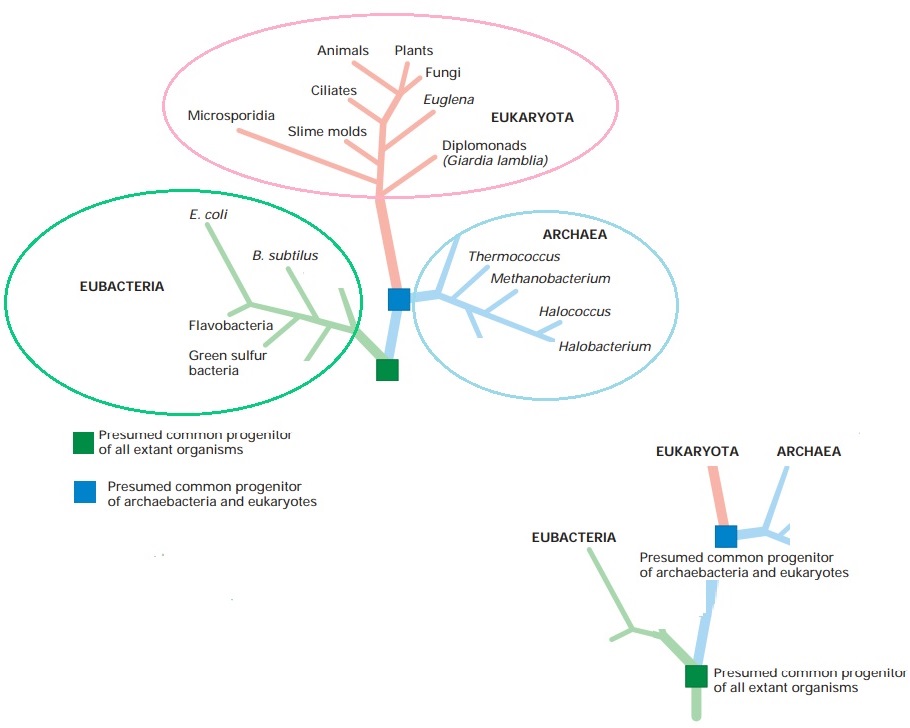
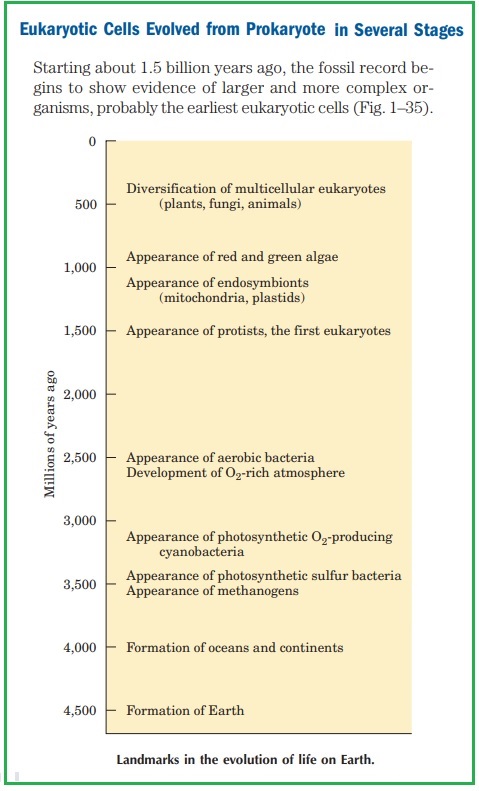
archea
bacteria
eukarya
Q.5. What is the root of biology?
Ans- Life on earth is remarkably diverse, ranging from the relatively simple unicellular organisms, such as bacteria, to more complex multicellular organisms, such as plants and humans. All organisms from simple bacteria to complex mammals probably evolved from a common, Last Universal Common Ancestor (LUCA) or single celled Pro-genote,. They got diversified by adapting themselves to various environmental factors during the course of evolution. So, Evolution is unifying feature in all life forms existing on earth. To root cause of enormous diversity in flora and fauna of earth is Evolution and hence it is considered to be the root of Biology.
Despite their diversity at the macroscopic level, where distinctive features of organisms are readily apparent with the naked eye, the core molecular features of all organisms are remarkably similar. So, life on Earth is being unified by a number of common themes.
- Development of Physical Barrier (Cell membrane): First, a living organism must be distinct in some way from its environment, that is, it must be defined by a physical barrier, which serves to separate ‘organism’ from ‘environment’. This separation allows the internal environment of an organism to be carefully regulated, and ultimately distinguishes ‘self’ from ‘non-self’. The physical barrier that developed was Cell membrane/Plasma membrane. The formation of self-replicating biological units called first cell or primitive cell is called Biological evolution or Biogeny. The Compartmentalization of the ocean water in Primitive Ocean was due to formation of unique class of molecules, termed as Lipids. Formation was Fatty acid in the primitive ocean was landmark in the history of evolution that resulted in the formation of fumdamental biological membrane of all cell types (both prokaryotes and eukaryotes) which we call Cell membrane/Plasma membrane/Plasmalemma.
- Development of Information storage device (RNA/DNA): Second, a living organism must be able to store information in a stable way, and also have a way of using this information to determine its characteristic features – its structural composition, how it functions, and so on.
- Replication mechanism of Nucleic acid (RNA/DNA): Third, a living organism must be able to reliably replicate and pass information from one generation to the next. Replication lies not only at the heart of the propagation of a species from generation to generation, but also at the heart of the growth and repair of a multicellular organism within a single generation. The processes of replication and transmission must remain faithful to the entity being replicated.
- Development of Energy generating system (Respiration/Photo- synthesis): Finally, living organisms require a source of energy from their surroundings to grow and reproduce; this energy is used to drive the biological processes that keep an organism alive. There are substantial differences in how energy is harvested by various organisms, for example, plants get their energy from the sun whereas humans get energy from food. Nevertheless, the core molecular mechanisms used by cells in all organisms to grow and propagate are remarkably similar (that is, they are highly conserved). For example, the same metabolic cycles are used in all organisms to transform sugars into the energy currency of the cell, adenosine triphosphate (ATP).
In modern-day organisms, the physical barrier that separates individuals from their surroundings is a lipid-based membrane, while a molecular species known as nucleic acid stores the biological information, and allows for ready replication of this information. These two basic molecular features come together–the lipid membrane surrounding the nucleic acid–to form the cell, which is the building block of organismal life. Some organisms are composed of a single cell (unicellular organisms) whereas others are formed of many cells (multicellular organisms).
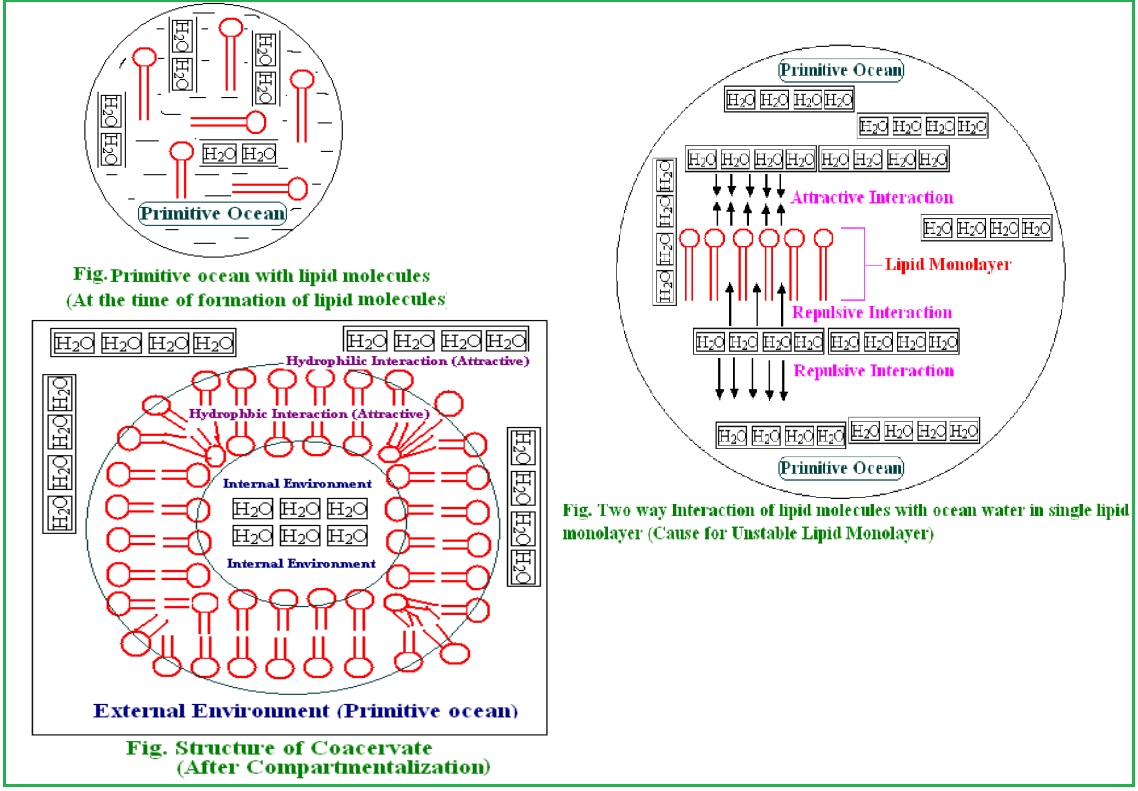
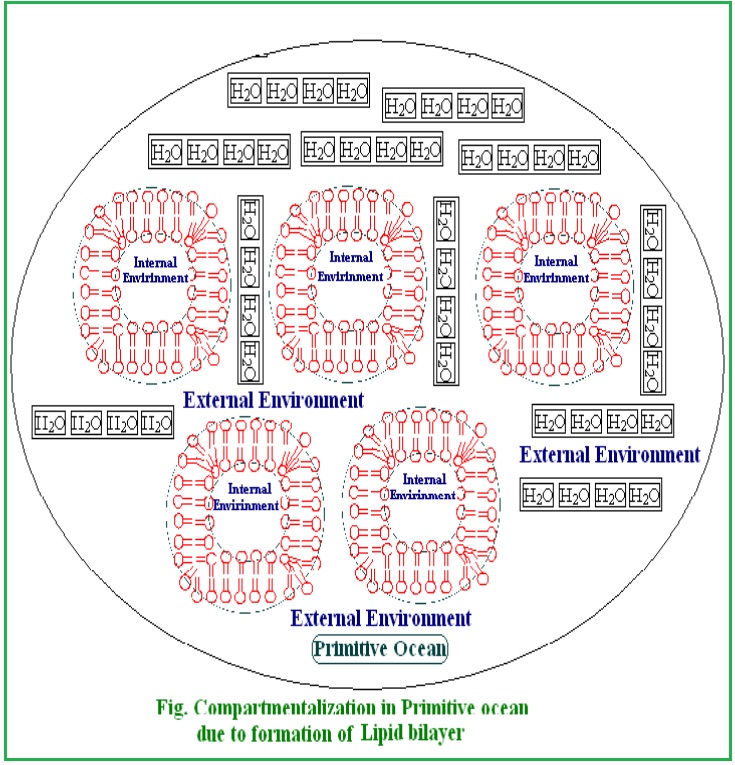
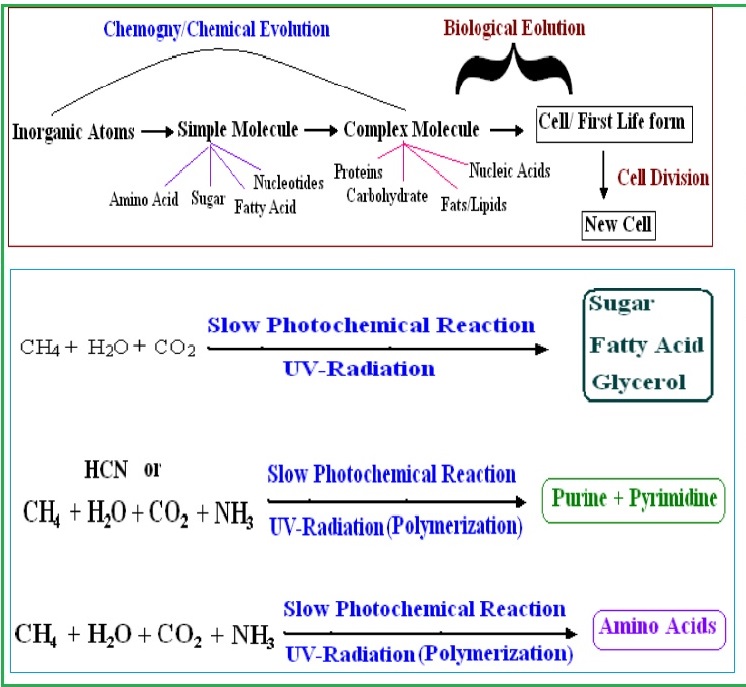
co-acervation
Compartmental-ization of ocean
Formation of simple molecule
Q.6. What type of biochemical connection occurs in the biological world?
Ans- Biology and chemistry converge in biochemistry, which is crucial to understanding the many complex factors and processes that keep living organisms (such as us) alive.
According to chemistry, Cell is a type of chemical engine powered by chemical reaction and according to biology, Cell is the structural, functional and fundamental or basic unit of life. The biological world is a maze of interconnections on a multitude of scales/levels of organization:
- Atoms join to form Small molecules like Sugar, Amino acids, Fatty acids and Nucleotides (Building blocks of complex bio-molecules)
- Small molecules clusters/combines to form large complex biomolecules like Carbohydrate/Protein/Lipids and Nucleic acids.
- Complex Molecules cluster to form cells. There are two fundamental classes of cell in the whole biological world (Prokaryotic cell and Eukaryotic cells)
- Cells interact to form tissues
- Tissues aggregate to form an organism. The interplay continues beyond the organism, as organisms form populations, populations inhabit ecosystems, and ecosystems unite to form the world around us.
Through all the layers of connectivity runs a common thread: the communication and onward passage of information–from cell to cell, from organism to organism and, ultimately, from generation to generation. This information is stored, at the most fundamental level, called Nucleic Acid in each living cell in our body. The sole role of Nucleic acid is storage and transmission of genetic information from one generation to other (through Transmission governed by Laws of heredity). The information for the formation of entire organism is present in the form of sequence of Nucleotides. The entire set of information present in an organismor a linear sequence of nucleotides in DNA (Blue-print for life) comprises the genetic makeup of an organism, called the genome of an organism is called Genome (Working Blue-print for life). This repository stores all information needed to specify cellular function and can be considered a blueprint for life. In the past decade, researchers across the world have determined the complete genome sequence of numerous organisms, from thousands of bacterial species to the human genome sequence.
But the surprise is how does this huge information so stored in nucleic acid become alive to direct the processes that constitute life? The answer lies in the structure and function of molecular components, which cooperate in a series of ingenious processes to bring the information deposited in our genome, to life. These components (Nucleic acid and Protein) and processes (Replication, Transcription and Translation) lie at the heart of molecular biology. These three processes constitutes “Central Dogma of life/ Molecular Biology“. The expression of gene/genome occurs at the level of protein. Proteins are synthesized by the process of Protein synthesis (Transcription and Translation). Gene Expression can thus be referred to as the process of Bringing Gene/Genome to Life. The uni-directional flow of information from DNA to Protein through RNA is called Central dogma of molecular biology.

Q.5. What type of connection occurs in the biological world?
Ans- Life on earth is remarkably diverse, ranging from the relatively simple unicellular organisms, such as bacteria, to more complex multicellular organisms, such as plants and humans. All organisms from simple bacteria to complex mammals probably evolved from a common, Last Universal Common Ancestor (LUCA) or single celled Pro-genote,. They got diversified by adapting themselves to various environmental factors during the course of evolution. So, Evolution is unifying feature in all life forms existing on earth. To root cause of enormous diversity in flora and fauna of earth is Evolution and hence it is considered to be the root of Biology.
Despite their diversity at the macroscopic level, where distinctive features of organisms are readily apparent with the naked eye, the core molecular features of all organisms are remarkably similar. So, life on Earth is being unified by a number of common themes.
- Development of Physical Barrier (Cell membrane): First, a living organism must be distinct in some way from its environment, that is, it must be defined by a physical barrier, which serves to separate ‘organism’ from ‘environment’. This separation allows the internal environment of an organism to be carefully regulated, and ultimately distinguishes ‘self’ from ‘non-self’. The physical barrier that developed was Cell membrane/Plasma membrane. The formation of self-replicating biological units called first cell or primitive cell is called Biological evolution or Biogeny. The Compartmentalization of the ocean water in Primitive Ocean was due to formation of unique class of molecules, termed as Lipids. Formation was Fatty acid in the primitive ocean was landmark in the history of evolution that resulted in the formation of fumdamental biological membrane of all cell types (both prokaryotes and eukaryotes) which we call Cell membrane/Plasma membrane/Plasmalemma.
- Development of Information storage device (RNA/DNA): Second, a living organism must be able to store information in a stable way, and also have a way of using this information to determine its characteristic features – its structural composition, how it functions, and so on.
- Replication mechanism of Nucleic acid (RNA/DNA): Third, a living organism must be able to reliably replicate and pass information from one generation to the next. Replication lies not only at the heart of the propagation of a species from generation to generation, but also at the heart of the growth and repair of a multicellular organism within a single generation. The processes of replication and transmission must remain faithful to the entity being replicated.
- Development of Energy generating system (Respiration/Photo- synthesis): Finally, living organisms require a source of energy from their surroundings to grow and reproduce; this energy is used to drive the biological processes that keep an organism alive. There are substantial differences in how energy is harvested by various organisms, for example, plants get their energy from the sun whereas humans get energy from food. Nevertheless, the core molecular mechanisms used by cells in all organisms to grow and propagate are remarkably similar (that is, they are highly conserved). For example, the same metabolic cycles are used in all organisms to transform sugars into the energy currency of the cell, adenosine triphosphate (ATP).
In modern-day organisms, the physical barrier that separates individuals from their surroundings is a lipid-based membrane, while a molecular species known as nucleic acid stores the biological information, and allows for ready replication of this information. These two basic molecular features come together–the lipid membrane surrounding the nucleic acid–to form the cell, which is the building block of organismal life. Some organisms are composed of a single cell (unicellular organisms) whereas others are formed of many cells (multicellular organisms).



cCoacervation
Compartmental-ization of ocean
Formation of simple molecule
next destination
Your Next Destination is to enter Biology zone to learn more according to your class of study.
